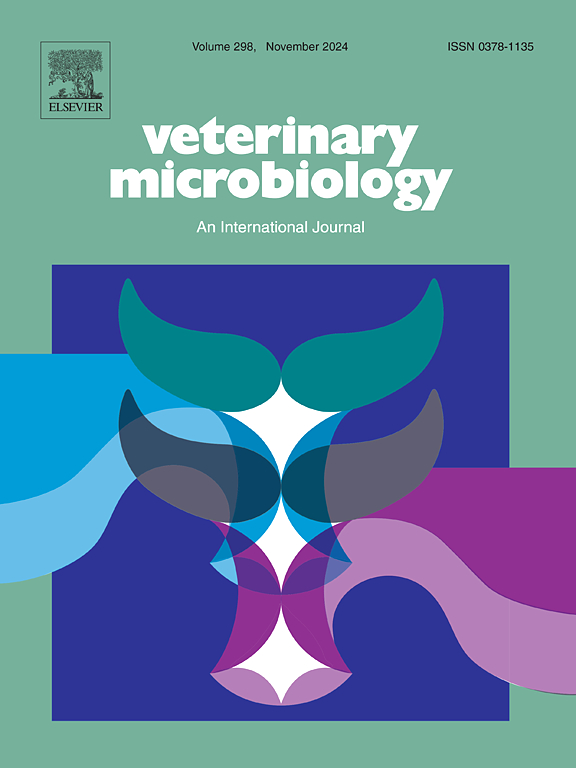基于基因型分析的胸膜肺炎放线杆菌 6 号血清 K6b:O3 新亚型。
IF 2.7
2区 农林科学
Q3 MICROBIOLOGY
引用次数: 0
摘要
我们分析了 15 个胸膜肺炎放线杆菌野外分离株(包括 11 个北美分离株和 4 个日本分离株)的胶囊(CPS)和脂多糖 O 抗原(O-Ag)生物合成位点,这些分离株对血清 3、6、8 和/或 15 抗血清反应。十个北美分离物扩增了来自荚膜位点的血清 6-指示性片段,而一个北美分离物和所有四个日本分离物扩增了血清 6-指示性片段以及血清 3-指示性片段。产生 3/6 带状模式的五个分离株含有一个 I 型 CPS 基因座,命名为 K6b,与血清 6 类似,但 cpxABCD 和 cpsABC 基因序列以及基因间区(modF-cpxA 和 cpsC-cpsD)的长度不同。K6 和 K6b cps 基因的主要区别在于,由于 Cps6bA C 端结构域的氨基酸替换,6b 型中的 113 AA UDP-糖基转移酶失去了功能。此外,这些分离株的 LPS O-Ag 基因座与 3、8、15、17 和 19 型血清的野外菌株和参考菌株的基因座高度一致,但与 6 型血清的基因座不同。综上所述,我们的研究结果表明胸膜肺炎甲菌存在一个亚型,即血清 6 型,我们称之为 "K6b:O3'',并建议以分离株 EH1248 作为参考菌株。本文章由计算机程序翻译,如有差异,请以英文原文为准。
A new subtype of serovar 6, K6b:O3, of Actinobacillus pleuropneumoniae based on genotypic analysis
We have analyzed the capsule (CPS) and the lipopolysaccharide O-Antigen (O-Ag) biosynthesis loci of fifteen field isolates of Actinobacillus pleuropneumoniae, including eleven North American and four Japanese ones, reactive to antisera against serovars 3, 6, 8 and/or 15. Ten North American isolates amplified a serovar 6-indicative fragment derived from the capsular loci, whereas one North American isolate and all four Japanese isolates amplified the serovar 6-indicative fragment as well as the serovar 3-indicative fragment. The five isolates producing a 3/6 banding pattern contain a type I CPS locus, named K6b, similar to serovar 6, but with differences in the cpxABCD and cpsABC gene sequences and the length of intergenic regions (modF-cpxA, and cpsC-cpsD). The main difference found between the K6 and K6b cps genes is a loss of function of a 113 AA UDP-glycosyltransferase found in type 6b due to the amino acid substitutions in the C-terminal domain of Cps6bA. Additionally, the isolates harbor a LPS O-Ag locus highly identical to those of field and reference strains of serovars 3, 8, 15, 17 and 19 but different from that of serovar 6. Taken together, our results indicate the existence of a subtype of A. pleuropneumoniae, serovar 6, that we called “K6b:O3′′, and we propose isolate EH1248 as the reference strain.
求助全文
通过发布文献求助,成功后即可免费获取论文全文。
去求助
来源期刊

Veterinary microbiology
农林科学-兽医学
CiteScore
5.90
自引率
6.10%
发文量
221
审稿时长
52 days
期刊介绍:
Veterinary Microbiology is concerned with microbial (bacterial, fungal, viral) diseases of domesticated vertebrate animals (livestock, companion animals, fur-bearing animals, game, poultry, fish) that supply food, other useful products or companionship. In addition, Microbial diseases of wild animals living in captivity, or as members of the feral fauna will also be considered if the infections are of interest because of their interrelation with humans (zoonoses) and/or domestic animals. Studies of antimicrobial resistance are also included, provided that the results represent a substantial advance in knowledge. Authors are strongly encouraged to read - prior to submission - the Editorials (''Scope or cope'' and ''Scope or cope II'') published previously in the journal. The Editors reserve the right to suggest submission to another journal for those papers which they feel would be more appropriate for consideration by that journal.
Original research papers of high quality and novelty on aspects of control, host response, molecular biology, pathogenesis, prevention, and treatment of microbial diseases of animals are published. Papers dealing primarily with immunology, epidemiology, molecular biology and antiviral or microbial agents will only be considered if they demonstrate a clear impact on a disease. Papers focusing solely on diagnostic techniques (such as another PCR protocol or ELISA) will not be published - focus should be on a microorganism and not on a particular technique. Papers only reporting microbial sequences, transcriptomics data, or proteomics data will not be considered unless the results represent a substantial advance in knowledge.
Drug trial papers will be considered if they have general application or significance. Papers on the identification of microorganisms will also be considered, but detailed taxonomic studies do not fall within the scope of the journal. Case reports will not be published, unless they have general application or contain novel aspects. Papers of geographically limited interest, which repeat what had been established elsewhere will not be considered. The readership of the journal is global.
 求助内容:
求助内容: 应助结果提醒方式:
应助结果提醒方式:


